Foreword
This is an invitation to get into the story of Marui, more exactly Tokyo Marui Co. Ltd, a japanese manufacturer widely known for years into the field of airsoft weapons. In the 80’s, Marui released a range of RC models that are often compared to Tamiya’s.
In my opinion, comparisons between Marui and Tamiya models were too often based on more or less objective statements about performance or quality. This is why I wanted to focus on another aspect: innovation brought by both manufacturers. To add more fun, models from Kyosho will also be invited into the comparisons.
Marui’s line-up
This is the complete list of Marui RC models sorted by release order. The series covers 5 years from 1983 to 1988, which is the period generally considered as the RC golden era.
Credit: Darryn’s Retro RC (modified)
Marui’s range of products is an excellent indicator of what the RC market was at the time. Models references were nothing more than the order in which they hit the market. But let’s have a closer look over the list since something important is hidden in the above image:
 |
| Kit # 1 – Super Wheelie Toyota Land Cruiser (1983) Kit # 2 – Super Wheelie CJ-7 Golden Eagle (1983) Kit # 3 – Hunter (1984) Kit # 4 – Big Bear (1984-1985) Kit # 5 – Galaxy (1985) Kit # 6 – Galaxy RS (1985) Kit # 7 – CJ-7 Golden Eagle (1985) Kit # 8 – Toyota Land Cruiser (1985) Kit # 9 – Mitsubishi Pajero (n/a) * Kit # 10 – Samurai (1986) Kit # 11 – Ninja (1987) Kit # 12 – Coors Melling Thunderbird (1988) Kit # 13 – Shogun (1988) |
First, please note that models release dates are mostly guesses based upon data found in period french magazines I found at retromodelisme.com. As it seems, model reference numbers should tell their order of appearance but release dates might be approximate since they depend on how and when the models were imported to France and then made available for magazines.
Last, you certainly noticed the missing 9th model: different sources state it should have been a Mitsubishi Pajero but strange problems about licensing would have forced Marui to cancel the model right before its release. It is nearly impossible to know for sure how the model would have looked. May be something like this:
Tamiya Mitsubishi Pajero (1984)

* since this review was published, the truth about the mysterious model #9 was revealed.
See there: RC9 Marui Mitsubishi Jeep kit #9
Marui Super Wheelies
These are Marui’s first two models released in 1983 and re-released 2 years later under the name CJ-7 Golden Eagle and Toyota Land Cruiser (kits #7 and 8), loosing the “Super Wheelie” name but now accepting 7.2v batteries. These models feature a mix between a pure leisure vehicle made for stunts by placing the battery at the rear of the chassis to make better wheelies and a more scale vehicle when moving the battery towards the center of the chassis. The chassis versatility combined with highly detailed bodyshells allow Marui to offer models that mark their differences compared to the current offer at the time.
| Marui Toyota Land Cruiser (1983/1986) | Tamiya Wild Willy M38 (1982) |
 |
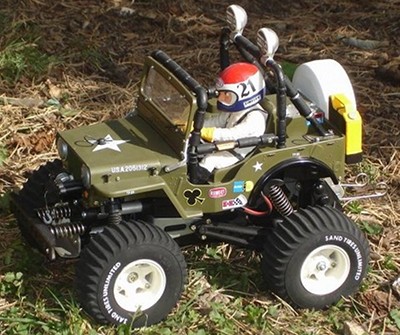 |
Credits: RC 4 Old Nuts / Julien from Vintage-RC.net
With these two first models (even 4 when considering their second life starting in 1985), Marui did not make a revolution into the RC world since Tamiya had released the Wild Willy with its detailed bodyshell a few months before. On its side, Kyosho already had released similar models with their Wheelie family, but for a 100% fun and on-road only usage.
| Kyosho / Graupner Mr Wheelie (1983?) | Kyosho Miss Wheelie (1982?) |
 |
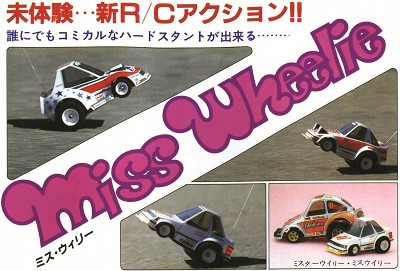 |
Credits: Marc MAURUS, Auto RCM #23 Août 1983 / Kyosho @ retromodelisme.com
Even if Miss seems to have been first, I couldn’t precisely date the Wheelie couple releases. Anyway, Kyosho made it and offered this comical way of driving to the RC world at the begining of the 80’s. However, this new comical way of driving became successful among fans thanks to Marui and Tamiya models, probably because they were offering more realistic bodyshells and had off-road abilities.
Anyway, Marui’s first steps into the RC world immediately demonstrate they will be a serious actor competing with the “big ones” on the market. Depending on countries, the public adopted the Super Wheelies so widely that Tamiya’s Wild Willy remained quite anonymous: special Super Wheelies races for beginners even took place, allowing everyone to compete with fun driving the same comical models. This is what happened in France where these models are considered as those that started the RC craze. Moreover, the very high detail standard of the bodyshells can be compared to Tamiya’s that was already a reference on the market: this is quite outstanding considering it was Marui’s debuts. More about the Marui Toyota Land Cruiser.
Marui Hunter
With their 3rd model, Marui wants to conqueer the promising 2WD leisure buggy market. The Tamiya Frog was just released (december 1983) and was already a great seller when the Hunter showed up in 1984. At the time, these two models were offering very decent performances thanks to their gearbox featuring a differential.
The Hunter suspension is quite original for the time since a unique hydraulic damper makes the job at the rear: this specific setup was already found on Tamiya’s Super Champ from 1982 and will later be the Hotshot “signature”. At the front too, the suspension is quite original at the time since it is “inboard”: the two friction dampers are placed horizontally into the bathtub chassis and work with a cantilver system. But the front suspension is not only original: it also features an anti bump-steer effect system. This complicated name describes something common on RC models: the front wheels are set parallel when the car stands idle, but they go in V shape as soon as the font suspension compresses (like when braking). And the front wheels goes the opposite shape when the front suspension fully decompresses (like when accelerating full throttle). Eliminating this effect every Tamiya Lunch Box owner knows is generally found on high-end models.
Marui Hunter (1984)
Credit: CIMB Drastic, Auto RCM #42 March 1985 @ retromodelisme.com
| Tamiya The Frog (1983) | |
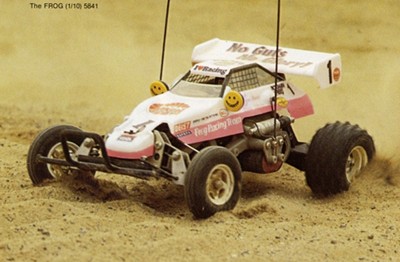 |
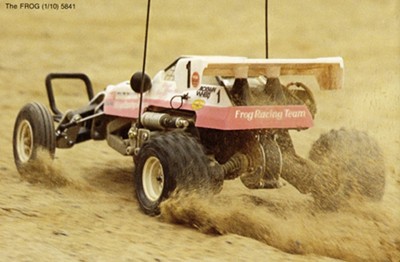 |
Credit: Tamiya
With the Hunter, Marui directly competes with Tamiya that already leads the leisure-oriented RC market. This is the begining of the RC golden age, and more specifically the begining of the buggy craze. Despite their very freesh venue on the RC market, Marui is already a serious pretender facing reknown competitors with an innovative model which performances are anything but ridiculous.
Marui Big Bear
Marui will make some big noise with their 4th model: by introducing a brand new type of vehicle, they will start a new craze other manufacturers will follow. In fact, the Big Bear story begins back in 1984 when Marui started to sell it by mail-order in Japan. This model too features a highly detailed and realistic bodyshell. But the best is under the bodyshell…
Marui Big Bear (1984-1985)
Credit: CIMB Drastic, Auto RCM #45 June 1985 @ retromodelisme.com
Indeed, the big wheels create a new concept that will widely inspire other manufacturers like Tamiya and Kyosho. If the Big Brute from Kyosho was quickly forgotten, Tamiya’s Blackfoot will become the reference model for fans in the 80’s.
| Tamiya Blackfoot (1986) | Kyosho Big Brute (1987) |
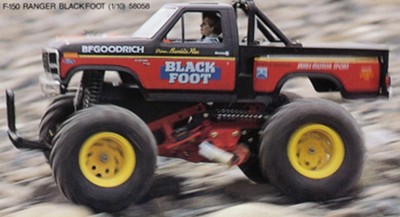 |
 |
Credits: Tamiya / David43 from Vintage-RC.net
With the Big Bear, Marui’s innovation is a surprise for their competitors. Unfortunately, Marui did not really benefit from this since this new market would only start a few years later when Tamiya released the Blackfoot. The Big Bear from Marui was a precursor for its time, but the lack of competition will not generate big sales on this model. In fact, this model will be Marui’s unique attempt at the big wheels category while competitors will later develop the concept.
Marui Galaxy and Galaxy RS
Marui comes back to the 2WD leisure-oriented buggy market when they release their 5th and 6th models. Main differences between the two versions are a 540 type motor and blue plastic parts on the RS while the economic version of the Galaxy runs a 360 type motor and features red plastic parts. In fact, both Galaxy models hide a Hunter chassis with a modified suspension.
| Marui Galaxy et Galaxy RS (1985) | Tamiya Hornet (1984) and Grasshopper (1983) |
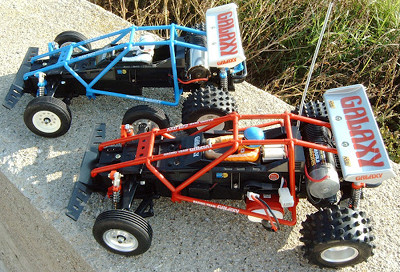 |
 |
Credits: Il Tempo Gigante / RC 4 Old Nuts – Black Hole Sun
Above, the second photo shows the models from Tamiya that the Galaxys were competing both on shelves and tracks in the 80s. Despite a better handling compared to the bouncing Tamiya models, the Galaxys sold considerably less than the Tamiyas: but all four models did their best to please the beginners.
Marui The Samurai
After the CJ-7 Golden Eagle and Toyota Land Cruiser we reviewed earlier, Marui releases their 9th model at the very begining of 1986. The Samurai is their first 4WD buggy and many fans will consider it as one of the most beautiful models of its time, both technically and aesthetically.
Marui The Samurai (1986)
Credit: optimamidpower from Vintage-RC.net
On store shelves and on the tracks, the Samurai meets Kyosho’s Gallop and Tamiya’s Hotshot. Apart from the 4 wheel steering, no one will miss the common genes between the Samurai and the Gallop.
| Kyosho Gallop (1984) | Tamiya Hotshot (1985) |
 |
 |
Credits: Kyosho @ retromodelisme.com / RC 4 Old Nuts – Black Hole Sun
Very soon, the Samurai will face new very exciting models from Kyosho and Tamiya:
Kyosho Optima (1985) Kyosho Javelin (1986) 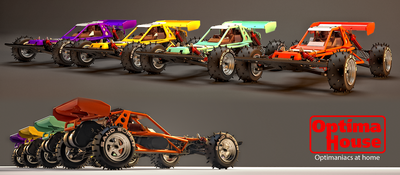
Credits: The Optima House |
Tamiya Supershot (1986)
Credits: F2G78 from Vintage-RC.net / Tamiya |
With the Samurai, Marui introduces a new elegant approach into the 4WD buggy world, trend that both Tamiya and Kyosho will immediately follow by releasing what still remains as some of their most exciting models ever.
Unfortunately, the Samurai became very rare and sought after, both because sales were not as important as the previous models’ and because very few models that were driven at the time could survive. However, its technical design is still considered as a reference for its time, despite being so fragile that it could never be seriously run. Aesthetically, RC fans usually consider it as one of the most beautiful buggy in RC History: an old debate is about which of the Samurai or the Javelin is the most beautiful.
Marui Ninja and Shogun
At the begining of 1987, Marui keeps on focusing on the buggy market with the release of the Ninja, their 11th model. The chassis design is entirely new: the Samurai used a chain-driven transmission into a frame chassis while the Ninja now uses a shaft-driven transmission into a bathtub chassis.
Marui Ninja (1987)
Credit: Auto RCM #67 April 1987 @ retromodelisme.com
Unlike the Samurai that was designed for serious racing, the Ninja is targetted to the leisure-oriented market. But on this segment, the Tamiya Boomerang and the Kyosho Rocky were already competing each other since 1986 and there was very spare room left for the new Ninja.
| Kyosho Rocky (1986) | Tamiya Boomerang (1986) |
 |
 |
Credits: Kyosho @ retromodelisme.com / Tamiya
In 1988, Marui releases the Shogun, their 13th and last model, but the market is already highly disputed. Apart from the look, the Shogun is an updated Ninja featuring an anti-roll bar and a slightly modified suspension geometry.
Marui Shogun (1988)
Credit: Patrick NICOLAS, Auto 8 #37 September 1988 @ retromodelisme.com
On Tamiya’s side, the Thunder Shot released at the end of 1987 already depicts their new 4WD buggy generation. Kyosho is also there with the release their new shaft-driven Shadow in 1988 that was very icy welcomed by the manufacturer’s fans and journalists. The reason is the shaft-driven transmission that “copies” Tamiya since chain-driven or the new belt-driven transmissions were Kyosho’s “signature” so far.
| Tamiya Thunder Shot (1987) | Kyosho Shadow (1988) |
 |
 |
Credits: Chris 86 from Vintage-RC.net / Kyosho @ retromodelisme.com
Marui’s last two buggies did not sell very well. Whereas the Samurai was very warmly welcomed, the Ninja and Shogun seem to have been quite anonymous and overwhelmed by the competition from Tamiya and Kyosho models. Compared to Marui’s previous models, one must admit these two buggies had far less arguments to compete. Anyway, even if they did not left a strong footprint into fans’ memories or the RC market at the time, these two models are important because they are the last productions of an RC manufacturer that made history. But beyond any consideration based on their own commercial success or interest, the Ninja, and above all the Shogun, had a major role into the RC History since they gave birth to Marui’s 12th model…
Marui Coors Melling Thunderbird
In 1988, Marui releases a model that is litterallty… outstanding! In fact, Marui’s designers were very smart: they understood that many buggies were driven on asphalt at the time. So they came with the brilliant idea to design a versatile model: the Coors Melling Thunderbird was born.
Marui Coors Melling Thunderbird (1988)
Credit: Régis & Yves Faucqueur, Buggy Mag #10 May/June 1989 @ retromodelisme.com
On this model, Marui reuses the chassis of the Shogun, their previous model, the evolution of the Ninja. Compared to the Shogun buggy, there are minor changes: damper adjusters in order to lower the ground clearance (limiting chassis roll) and two complete wheel sets, one for asphalt and the other one for off-roading. In fact, the last set is better suited for rallying than for true off-roading.
It is almost impossible to compare the Coors Melling Thunderbird with other manufacturers models at the time: simply because they don’t exist. Nevertheless, the following Tamiya models can be considered:
| Tamiya Porsche 959 (1986) | Tamiya Ford Escort RS Cosworth (1993) |
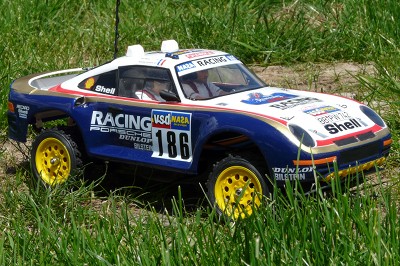 |
 |
Credits: Black Hole Sun / Tamiya
Let’s be clear: the Tamiya Porsche 959 from 1986 is probably the closest model to the Coors concept. But, running the Porsche on asphalt required optional slick tires and the chassis offered no tuning setup to make it better suit the pure on-road usage. Moreover, the chassis had been specifically designed for this model (and its twin the Toyota Celica): it was not an existing chassis converted to another usage as the Coors’ with the Ninja/Shogun chassis.
However, the Tamiya Ford Escort RS Cosworth (kit 58112) can directly be compared to the Coors that was released 5 years(!) before. It is based on Tamiya’s famous TA-01 chassis, but in rallye version (asphalt tires are available separately though). As for the chassis, it comes in straight line from the DF-01 Manta Ray buggy released in 1990. This time, there are direct genes between a buggy chassis and a versatile version for on-road and rallye usage. A concept Marui had introduced five years before, back in 1988.
At Kyosho’s, there is is no real equivalent: apart from using the Ultima chassis for a pure on-road series of models that did not seem to have found their public, there is nothing like the Coors. In fact, the Ultima chassis on-road conversion is even limited to changing the wheels. More about the Kyosho Nissan Saurus.
| Kyosho Nissan Saurus (1990) | Kyosho Ultima Scale Series Lamborghini Countach (1990) |
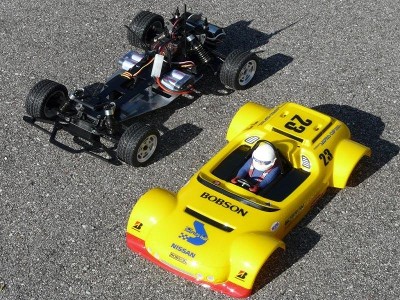 |
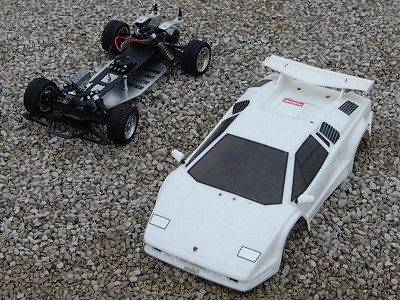 |
Credits: RC 4 Old Nuts / Neb from Vintage-RC.net
With the Coors Melling Thunderbird, no doubt Marui significantly changed the RC world in depth. By using a buggy chassis to offer a versatile on-road/rally model, Marui introduced a new category responding to the fans’ usage. As with their Big Bear at its time, Marui was again pretty in advance over its time and competitors.
Conclusion
In addition to airsoft, Marui is still active into RC, but only with helicopters, flying robots and tanks. However, they totally stepped out from the classic RC surface market (apart from tanks). Unfortunetly, their remarkable contribution to our hobby History got forgotten by most of the fans.
Depending on countries, Marui had a considerable impact over the RC in the 80’s, but most of all, into fans’ hearts. Specifically, this was very significant in France where period magazines are testimonies of Marui’s crucial role on the market. Thanks to retromodelisme.com website, one can rapidly realize how much period journalists were enthusiasts about Marui’s models, but also that they all seemed unaware about the models fragility.
I purposefully left economical considerations apart from this panorama, despite the price of a model being significant. Unfortunately, it is very difficult to be precise more than 25 years later, especially because the spare information I could collect is often not concordant.
Nevertheless, generally speaking, Marui’s price strategy was quite aggressive in France (probably in the rest of the world too): of course, the price is a serious argument to explain the success of the models. But considering the sole price would deny the enthusiasm the models made into fans’ hearts.
Today, Marui models only left somekind of blurred nostalgia to those who discovered RC with these models, or even virtual indifference for those who preferred Tamiya and Kyosho models at the time. The lack of information still available today, but most of all, the very few models that survived until today do not help to remember how much Marui is important to the overall RC History (note the uppercase). If we consider innovation and models specifications, especially when you compare them to Tamiya’s and Kyosho’s at the time, we are forced to admit that the period RC (and today’s) would have been very different without Marui. Yes, the plastic quality was not the best and probably explains somekind of frustration about the models being so fragile: but I consider this flaw should not hide all the rest.
With this article, my goal was to make you (re)discover an aspect of the RC History of the 80’s. But also to pay tribute to a manufacturer which models highly influenced and contributed to our hobby. I hope I achieved this goal.
Note from the author
Those of you who know my website and my enthusiasm for Tamiya may be surprised I wrote this article.
Here’s why: it is time for me to warmly thank two persons. David from RC4ON for offering me room to write this article. Most of all, for his friendship and for offering me a much wider view over our hobby with his impressive collection. I also want to make a special thank to Lonestar, for encouraging me to remove my “Tamiya blinders”.
Each of you, with different manners, you help me better understand and like our hobby. Thank you.


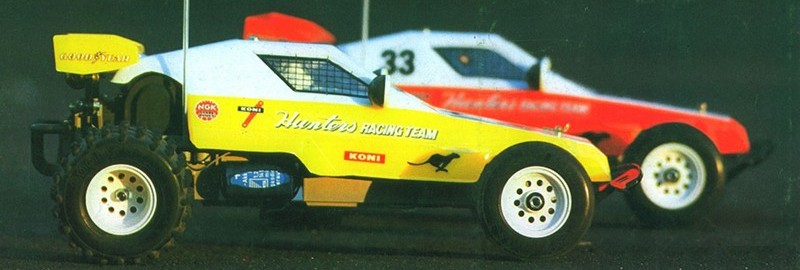



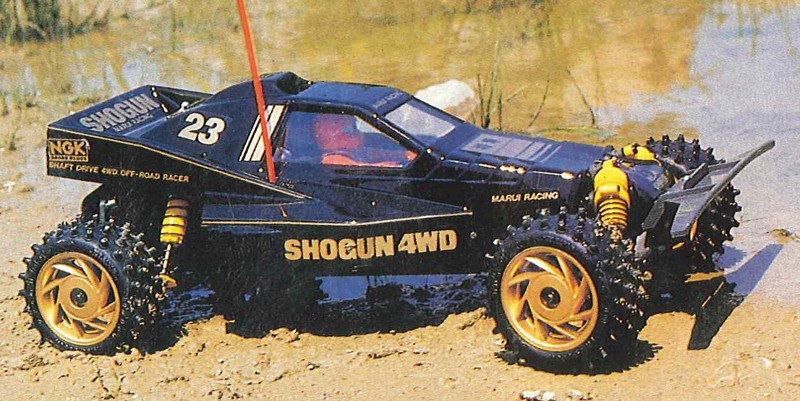

9 comments on “The story of Marui”
Thank you very much for giving back Marui place onto the podium next to the others big Japan manufacturers
He ben tu vois, BHS, quand tu veux… good work, crisp and informative, unbiased… keep it up :)
Thanks for this nice article…
But there might be some imperfections on the dates of release of the models. The two numbers after MT in the kit numbers seemed to be linked with the year of release of the kit (see the pictures of the catalog from 1986, those are indicated)
If we follow this logic :
MT58-01 & 02 were released in 1983 : Super Wheelie CJ-7 and Land Cruisers
MT59-03 & 04 were released in 1984 : Hunter and Big-bear
MT60- 05, 06 were release in 1985 : Galaxy and Galaxy RS
MT60-07, 08, and 10 were likely to be released in 1985. The Samurai was present in a flyer dated December 1985 from Amerang (British Importer), and was likely in stores with price tag less than 100GBP in december 1985 in UK.
MT61-11 was then likely released at the end of 1986 (Ninja)
I did not find the kit numbers for the Coors and the Shogun, but their manuals seems to indicate a release in August 1987 for the Coors and in December 1987 for the Shogun…
It would be great to see other articles like this one for other brands :)
Japanese dates conversion confirms theory on the years of release :
Source : https://notesofnomads.com/japanese-date-system/
Good Job ! Thank you for this informations
Do you know where to find spare parts for the 1987 landcruiser. I need a front arm set
Hi Lars,
You need to check on Ebay, local auction, and some vintage rc forum :-)
Etant fan de cette marque et sur laquelle j ai debute , je tiens a dire super boulo , merci
Hallo.Super Artikel. Mein Herz schlägt zwar für die alten Tamiya und kyosho Rc’s, aber marui ist eine Ikone.